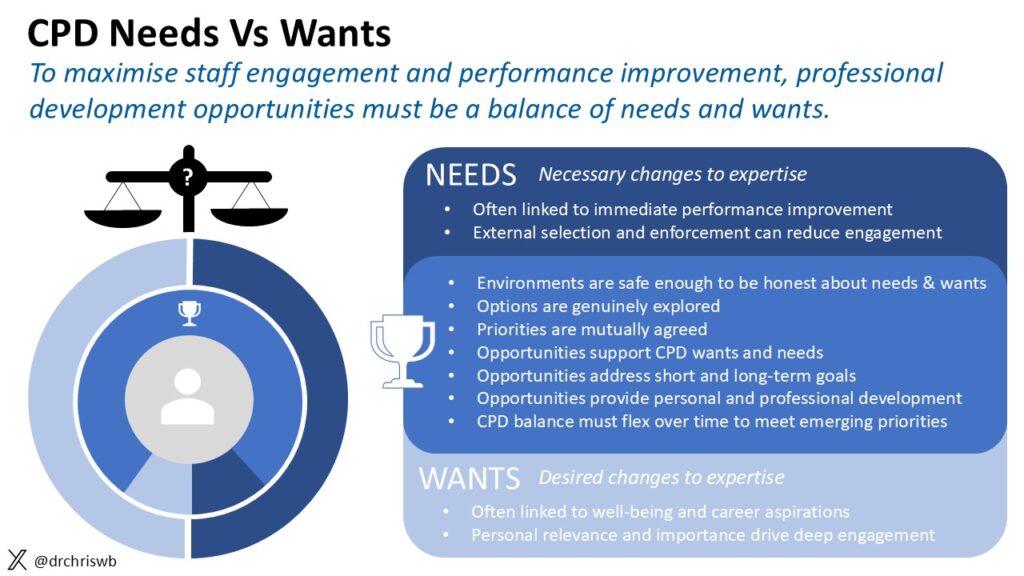In this post, we will explore the need to create a broad and balanced professional development programme which both addresses what individuals, groups and academies need to improve and what they want to improve
How can we balance the CPD NEEDS and WANTS of our staff to maximise engagement & development?

WHAT?
Sadly, the time available for professional development is a fraction of what we would like to have and need to have to maximise improvements to practice. This scarcity often means that leaders of PD need to make difficult decisions about how to use that time and facilitate Trust, Academy, Team, and Individual development. PD leads are also faced with the tricky challenge of balancing the immediate needs of staff that are required for rapid performance improvement and the PD wants and desires of individuals that maybe linked to career progression and well-being.
WHY?
Balancing PD needs and wants is an important consideration for leaders as it can impact on both the performance improvement of staff and their levels of engagement with PD and their enactment of it into their practice.
Performance Improvement
If we believe that our levels of expertise direct our behaviour and our actions direct our impact, then we must invest time and energy in professional development if we want to improve performance. In situations where levels of motivation are high, it is often the case that staff are less effective because of gaps or misconceptions in their knowledge, experience, or skills. If we hold pupil experience and outcomes at the heart of our mission, then we must maintain high expectations of staff performance and ensure that the professional development enables them to maximise their effectiveness.
Engagement and Enactment
If we acknowledge that levels of engagement with PD directly affect the transfer of training into practice, then we must consider the impact that PD design and provision has on staff motivation. Knowle’s Andragogical assumptions suggest that adults have much more control over their learning and demand relevance, utility, and choice if they are going to fully engage. Leaders also need to consider the impact that a lack of personalisation and an imbalance between needs and wants can have on an individual’s sense of recognition, belonging and well-being.
HOW?
Psychological Safety
One of the initial challenges for leaders is to create environments that are safe enough for staff to be honest about their needs & wants. If we don’t know our staff well enough, then we won’t be able to provide them with the most effective professional development. With that in mind, leaders must ensure that they model vulnerability, so staff feel safe to communicate openly and at the same time proactively seek out information about career aspirations and well-being needs.
Partnership
If we are striving to balance PD needs and wants, then processes like line management and performance management must be seen as a partnership. Staff need to feel that their voices are heard, and that the identification of PD needs is not done for them but through collaborative creation. Options for development should be genuinely explored before being prioritized and staff should always feel that PD balances a focus on their perceived development needs and those observed by others.
Prioritisation
The complexity of roles and performance mean that there are typically a vast number of different elements that could be tweaked through professional development. It is important that staff are supported to prioritise elements which hold the most leverage and promise the biggest impact. PD opportunities should address short and long-term goals and where possible balance movement towards both performance and outcome goals.
Personalisation
The scarcity of time and the size of organisations means that personalised professional development is often a challenge that is hard to solve. Perceived relevance and utility are two are the biggest contributors to staff PD engagement and so we must where possible provide elements of choice. To achieve this, PD leaders can allocate and specifically assign time to personalised PD, provide opportunities for self-study, allow a degree of PD selection, and create levels of difficult that match the varying experience.
As always this leaves us at the start of a conversation and for this topic specifically:
